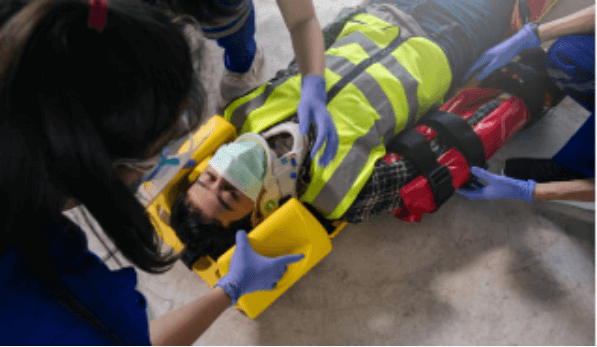The characteristics of a rescue determine the type of stretcher to use. The standard stretcher can help you in rescuing patients with minor injuries. Severe injuries require specialized equipment such as a vacuum stretcher. The vacuum stretcher is designed for specific rescues, which we will discuss today.
Spinal or pelvic injuries are rescues suitable for a vacuum stretcher because they’re delicate, and any wrong move can worsen the wound. The vacuum stretcher helps to ensure immobility, keeping the patient safe. It also provides an air cushion that absorbs shocks that could move the injured area.
Let’s examine these rescues in more detail.
Table of Contents
Toggle1 – Spinal Injury Rescue
Keeping the patient immobile is vital when rescuing a spinal injury patient. Permanent paralysis could result if the injured area of the spine moves. Preventing these complications depends on your ability to identify a spinal injury.
How Do You Diagnose a Spinal Injury?
The symptoms of spinal injuries depend on the extent of the injury. Some signs to look for include:
- An apparent head injury. Since the spine is connected to the brain, a head injury could indicate a spinal injury.
- Severe pains in the back or neck. Spinal injuries are not always visible. If the patient complains of back or neck pains, assume they have spinal injuries.
- An injured back. If you can tell that an impact on the back caused the casualty’s injury, assume a spinal injury.
- If the patient complains of numbness, weakness, paralysis, or can’t control their bowels, bladder, or limbs.
- If you find their neck or body twisted unusually.
Preparing a Vacuum Stretcher for a Rescue
Preparation is critical to ensure the casualty’s safety. The following steps will help get your vacuum stretcher ready:
- Step #1: Prepare the trolley. Ensure all straps are over its edge so they don’t go underneath the vacuum mattress.
- Step #2: Remove the headrest from the packaging and lower infusion poles so they lie in a horizontal position.
- Step #3: Remove the folded vacuum mattress from the packaging and place it over the trolley. Ensure you place the vacuum mattress properly to ensure equal weight distribution.
- Step #4: Inspect the vacuum mattress valve and the mattress. Remove bumps or lumps. The vacuum stretcher is ready for use.
Transferring the Casualty Onto the Vacuum Stretcher
Since immobility is critical, use a scoop stretcher to make the transfer. Prepare the casualty before transferring them. Preparation involves securing the neck and head area using a brace, as shown below:

Alt: paramedic securing a patient’s neck and head area
Follow these steps to ensure the casualty’s safety:
- Step #1: Adjust the scoop stretcher to the casualty’s height. Manufacturers recommend that you adjust the stretcher’s length before uncoupling it to ensure uniform adjustment of the two halves.
- Step #2: Unlock the two twin safety locks to separate the two halves. One lock is at the head section, while the other is at the foot. Ensure you press the two buttons simultaneously to unlock.
- Step #3: Lift the casualty onto one half of the scoop stretcher. Ensure one of you supports the casualty’s head and neck section to prevent movement. The side lift involves inclining the patient approximately 10 to 20 degrees laterally. Avoid log rolling because it can cause unnecessary life-threatening movements.
- Step #4: Lift the casualty slightly on the other side to place the other half underneath them.
- Step #5: Align the two halves while the patient is still in the inclined position. Lock the two halves together. You will hear a clicking sound that confirms that they are securely locked.
- Step #6: Ensure the casualty is comfortable. Ensure the stretcher isn’t pinching them. Check whether you need additional cushioning to hold your head in position.

Alt: paramedics placing extra cushioning for patient comfort
Step #7: Secure your patient to the scoop stretcher using restraints.
Now your patient is ready to be transferred to the vacuum stretcher.
Transferring the patient to the Vacuum Stretcher
- Step #1: Carry the scoop stretcher and place it over the vacuum stretcher. Position the patient at the center of the vacuum stretcher. One of you will coordinate the process to ensure everything is done right.
- Step #2: Remove the scoop stretcher. Removing the scoop stretcher doesn’t require rolling the casualty, but you must maintain spinal alignment. Once you remove the harness, unlock the twin safety locks beginning with the one at the casualty’s head. Once the halves are separated, slide away one half at a time to ensure minimal patient movement.
- Step #3: Deflate the vacuum mattress. Release all the air from the vacuum mattress until it feels pliable. Wrap the vacuum mattress around the casualty. Below is a picture of a wrapped patient:

Alt: vacuum mattress wrapped around a patient
- Step #4: Pump air into the vacuum mattress until it feels hard.
- Step #5: Secure the patient to the vacuum stretcher using the trolley’s straps.
2 – Fractured Pelvis Rescue
This injury usually occurs after a high-impact fall or collision in the pelvis area. Perform first aid before transferring the patient to the vacuum stretcher.
First Aid for Pelvic Injury
If the patient is awake, give them some painkillers to ease the pain. Next, use the two tourniquets, a splint, and tape for this procedure to stabilize the pelvic area.
- Step #1: Prevent the outward rotational movement around the casualty’s pelvis. The best way to do this is to tie their ankles together using tape. If you don’t have tape, you could use their shoelaces.
- Step #2: Join the tourniquets and adjust their length so they can go around the patient’s hips and leave an overlap of approximately six inches. The overlap provides room for the splints.
- Step #3: Tape the splint to the tourniquets to prevent slippage
- Step #4: Position the setup under the casualty. Ensure it’s at the widest part of their hips.
- Step #5: Tighten the tourniquet so a finger can’t squeeze in.
Transfer to a Vacuum Stretcher
Pelvic injuries can be life-threatening if not handled carefully. Since immobility is critical, you’ll also need a scoop stretcher to transfer them to the vacuum stretcher.
As with the spinal injury, avoid log rolling the casualty. Lift them slightly while inserting each half of the scoop stretcher before locking.
The transfer process to the vacuum stretcher is the same as the one discussed above for spinal injuries.
Wrapping Up
The rescues suitable for the vacuum stretcher are the spine injury and pelvic fractures. Both rescues emphasize immobilization. Use a scoop stretcher to move the casualty onto the vacuum stretcher. The vacuum stretcher provides cushioning and immobilizes the patients, preventing further injuries.
Frequently Asked Questions
What precautions must I take when handling a patient with a spinal injury?
Never move the injured area. Moving the spine can endanger the casualty’s life.
Why is it necessary to use a scoop stretcher with a vacuum stretcher?
The scoop stretcher allows you to place the casualty on the vacuum stretcher without moving the injured area.
Why is a vacuum stretcher suitable for spinal fractures?
A vacuum stretcher is suitable for spinal injuries because it molds to the casualty’s body while reducing pressure on the injured areas. It also increases the casualty’s comfort during transfer.



